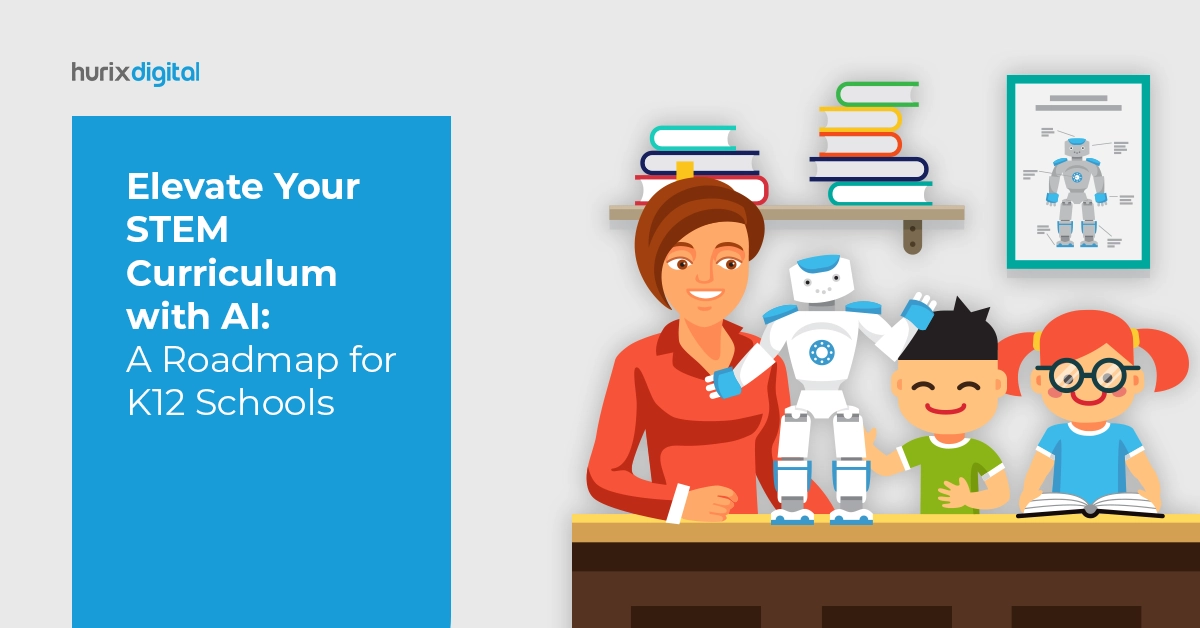Nitin Sharma
December 28, 2023
Elevate Your STEM Curriculum with AI: A Roadmap for K12 Schools
Summary
This roadmap will provide you with the information you need to create a curriculum that utilizes AI in a meaningful way.
Educators across the globe are pivoting to meet the needs of their students. The advent of new technology is fundamental to this initiative, but it simply cannot be achieved alone. We’re on the cusp of a generational shift that will impact fields across academic disciplines and workplaces for years to come.
AI-related technologies have surpassed expectations by penetrating human society faster than any other technology in history. Since 2020, AI has created over 97 million new jobs globally.
To truly optimize your K12 education system, it is more imperative than ever to include AI in the STEM education (Science, Technology, Engineering, and Mathematics) curriculum.
Table of Contents:
- Why Should You Use Artificial Intelligence in the K12 Curriculum?
- AI-Powered STEM Learning- An Introduction
- Roadmap to Integrate Artificial Intelligence in the K12 Curriculum
- What are the Four Tips to Employ AI in K12 Education?
- Final Thoughts
Why Should You Use Artificial Intelligence in the K12 Curriculum?
The most common argument for using AI curriculum for K-12 is that it will make learning more effective in the following ways:- Providing students with personalized feedback
- Helping them explore topics in depth through self-guided lessons
- Making learning more personal and tailored to individual needs
- Improving teaching quality by making lesson plans easier and faster to create
- Saving teachers time so they can focus on individual student needs
AI-Powered STEM Learning- An Introduction
AI applications have been used to solve many problems in various fields, including logistics, speech recognition, data mining, and medical diagnosis. Below are the ways to transform STEM education with AI: For Teachers:- Identify patterns in large data sets that humans might miss
- Automate processes that require expertise or human judgment
- Enable computers to collaborate with people more effectively
- Monitor student behavior and provide targeted intervention
- Curate training sessions for topics like classroom management, lesson planning, or content delivery strategies
- Provide real-time feedback to guide students in their learning process
- Address gaps in students’ understanding of real-time data
- Develop a data-driven culture to help students become analytical and critical thinkers
Roadmap to Integrate Artificial Intelligence in the K12 Curriculum
Artificial intelligence (AI) is a powerful tool that can be used to enhance education in the K-12 setting and understand the benefits of AI in STEM education. The first step is to understand the scope of AI — it’s not just about teaching students how to code or program machines with algorithms. The goal of integrating AI into education is to provide students with an understanding of how technology works so they can use it effectively in the real world. It’s also important that teachers understand that computers are not intelligent by themselves; they are only as smart as their human operators allow them to be. The following steps will help you integrate AI into curriculum development:1. Curate a Learning Technology Plan
It will help you identify what technology tools you currently have access to in your school and which ones you want to incorporate into your curriculum. It also helps you determine how much funding you’ll need to make this happen. This plan should outline which AI tools will be used in each grade level, as well as how they’ll be integrated into different subjects like math, science, and language arts. Hence, AI for K-12 schools is of the essence.2. Systematically Create Curriculum Units and Lessons with AI
Next, create units and lessons that incorporate artificial intelligence into core subjects like math and science. This means creating units that help students learn about robotics or autonomous vehicles. For example, if you’re planning on using an intelligent chatbot to teach chemistry lessons, you’ll need to outline exactly how it will work with students during each phase of the unit. Also, make sure that these units align with standards laid out by state departments of education.3. Train Teachers on How to Use AI to Teach Students
Identify your core competencies as a teacher or school leader. For example, if you want to use AI to train students on science topics like biology or chemistry, then select a core competency such as biology or chemistry as one of your main categories. You can also combine multiple competencies so that they form an overarching theme, such as STEM (science, technology, engineering, and math). Next, training will be done through workshops, guest presentations, or in-classroom tutorials. Additionally, many schools are now offering courses in machine learning and deep learning that can be taken by teachers as well as students.4. Measure the Impact of Your AI-Enhanced Curriculum
You can do this by conducting surveys and interviews with teachers, students, and parents before and after they use an AI system. You should also perform academic testing (such as standardized tests) before and after implementing an AI system so that you can see if there are any improvements in student performance due to its use. For example, if a teacher wants to know how well their class did on an assignment, they could use AI to analyze their data and identify which students need extra help or which concepts need more emphasis during class time.What are the Four Tips to Employ AI in K12 Education?
AI can be used to teach students how to think like a scientist or researcher, solve problems creatively, and design solutions that will be useful in the real world. It also helps them develop critical thinking skills and problem-solving abilities that are essential for success in life after graduation. Here are a few handy tips for educators and learners to speed up the integration process of ai-powered STEM learning:For Learners
1. Sparking Curiosity: Introduce AI through Playful Explorations
- Challenge: Dive into the world of AI through interactive activities and quizzes
- Mission: Build mini-robots or program a virtual creature to navigate a maze
- Outcome: Uncover the secrets of machine learning by analyzing data patterns in interactive games
2. Building Brains: From Learners to Creators of AI
- Coding Camp: Craft a helpful AI bot that answers questions, schedules tasks or assignments
- Algorithm Arena: Design a competitive AI game where players program their strategies to conquer opponents
- Level Up: Learn game development techniques and incorporate AI elements into your interactive creations
For Educators
3. Leveling Up: Understanding AI Through Playful Interactions
- Behind the Scenes: Explore the mechanics of AI in popular video games and analyze how algorithms govern movement, decision-making, and enemy behavior
- Grading Games: Utilize machine learning tools to automate test scoring, freeing up time for personalized feedback and deeper learning discussions
- Algo Architects: Master the art of algorithm design and build custom solutions for real-world problems your students care about
4. Immersive Experiences: Learning in an AI-Powered World
- AI Playground: Craft a collaborative classroom environment where students interact with AI-powered tools, assistants, and even adaptive learning platforms
- Storytelling with AI: Design a choose-your-own-adventure story where AI helps personalize the narrative based on students’ choices and preferences
- Future Vision: Imagine and prototype educational tools and experiences that seamlessly integrate AI to enhance learning, engagement, and personalized growth
Final Thoughts
Rising waves of change are already transforming the existing landscape of STEM education. These trends will continue to grow in strength, and it will become increasingly critical for schools to incorporate affordable AI solutions into their learning programs and help in STEM curriculum enhancement. Doing so ensures that children are prepared to face the real-world challenges they will inevitably confront in the future while helping to smooth the transition from educational institutions into emotionally fulfilling careers. If you’re looking for fresh ways to raise the impact of AI-powered STEM learning, the all-in-one digital suite provided by Hurix Digital can give you ideas on how to engage students and improve their skills. Get access to over 2500 interactive learning modules in Maths and Science. Look into these resources today and see how you can apply AI to your teaching tomorrow. Book a free demo!
Senior Vice President
A Business Development professional with >20 years of experience with strong capability to sell new solutions and develop new markets from scratch. New Market Entry Specialist with experience working in the largest emerging markets. Exceptional experience in conceptualizing, ideating and selling new learning technologies like VR AR, etc. across multiple industry verticals.









